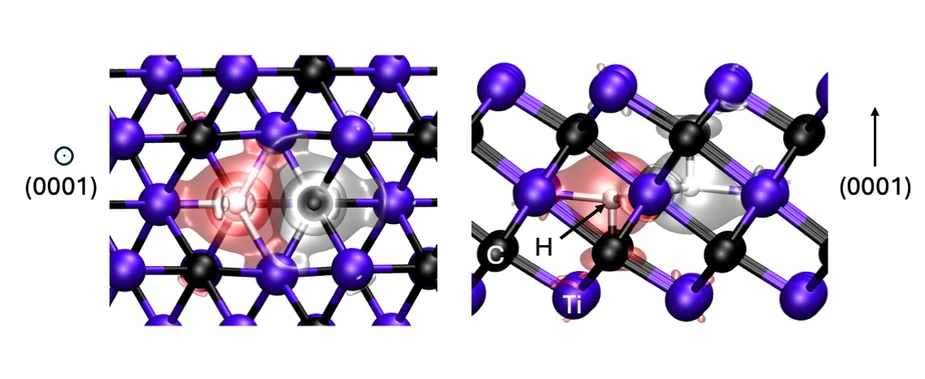Diffusion of hydrogen in MXene investigated at HZB
Modelling offers a solid foundation for further research with MXene as hydrogen storage systems
Two-dimensional (2D) materials such as MXene are of great interest for hydrogen storage. An expert from HZB has investigated the diffusion of hydrogen in MXene using density functional theory. This modelling provides valuable insights into the key diffusion mechanisms and hydrogen's interaction with Ti₃C₂ MXene, offering a solid foundation for further experimental research.
Hydrogen is an energy carrier that can be produced in a climate-friendly way by electrolysis of water using ‘green’ electricity. However, storing hydrogen is not that easy. MXene could be a promising solution. MXene are compounds of metal and nitrogen or carbon that form a two-dimensional hexagonal structure, giving them special physical and chemical properties. Atoms and molecules, such as hydrogen, can be stored both in and between the 2D layers. ‘However, we know that hydrogen atoms and even molecules form complex bonds in MXene and on its surfaces,’ says Prof. Dr. Norbert Nickel, a physicist at HZB. When storing hydrogen, it is also important that the hydrogen bound in the material can be released when needed.
Previous neutron scattering experiments have shown that hydrogen can be stored in the MXene material Ti3C2. However, in 2024, Nickel calculated exactly how the hydrogen orbitals interact with the titanium and carbon orbitals using density functional theory. These results shed light on the nature of hydrogen's chemical bonding and how temperature affects the diffusion process (see Annalen der Physik, 536, 2400011 (2024)). Nevertheless, quantum mechanical calculations of the interactions between hydrogen atoms and molecules with Ti₃C₂ show that the simple model of chemical bonding is insufficient to describe hydrogen's bonding properties.
Recently Nickel analysed the chemical orbitals in more detail: the calculations showed that interstitial hydrogen atoms and molecules form s-like bonds with neighbouring titanium atoms and s-p hybrid orbitals with neighbouring carbon atoms.
For the diffusion process, it is important that these bonds can be broken. In solids, foreign atoms, such as hydrogen, can diffuse either via vacancies or via interstitial sites. Diffusion therefore depends on the concentration of vacancies and interstitial sites. ‘Modelling shows that hydrogen transport in Ti3C2 occurs via interstitial sites and that diffusion via vacancies plays no role,’ Nickel summarises the results. This allows hydrogen atoms and molecules in Ti3C2 MXene to achieve high mobility with diffusion coefficients of 2.4 × 10−5 cm−2/s at a moderate temperature of 500 K.
Calculations of the orbital interactions between hydrogen and Ti₃C₂ also enable the parameter ranges in which particularly interesting experimental observations can be expected to be estimated in advance for the first time, for example with spectroscopic measurements at BESSY II.
Publication:
Nano Letters (2025): Hydrogen Diffusion in Ti3C2 MXenes
Norbert H. Nickel
DOI: 10.1021/acs.nanolett.4c05749
Contact:
Prof. Dr. Norbert Nickel
Helmholtz-Zentrum Berlin für Materialien und Energie
Young Investigator Group Nanoscale Solid-Liquid Interfaces
+49 30 8062-17159
nickel(at)helmholtz-berlin.de
Press release HZB, 23 June 2025
